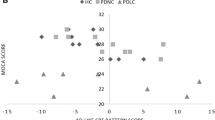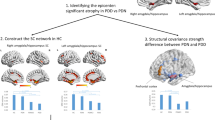Abstract
Introduction
Previous studies have found that white matter (WM) alterations might be correlated in Parkinson’s disease (PD) patients with cognitive impairment. This study aimed to investigate WM structural network connectome alterations in PD patients with mild cognitive impairment (PD-MCI) and assess the relationship between cognitive impairment and structural topological network changes in PD patients.
Methods
All 31 healthy controls (HCs) and 71 PD patients (43 PD-NC and 28 PD-MCI) matched for age, sex and education underwent 3.0 T MRI and diffusion tensor imaging (DTI) scan. Graph theoretical analyses and network-based statistical (NBS) analyses were performed to identify the structural WM networks and subnetwork changes in PD-MCI.
Results
PD-MCI patients showed significantly decreased global efficiency (Eglob) and increased shortest path length (Lp) compared with the HC group. Several nodal efficiencies showed significant differences in multiple brain regions among the three groups. The nodal efficiency of the orbitofrontal part was closely related to the overall cognitive ability and multiple sub-cognitive domains. Moreover, NBS analyses identified eight one-connect subnetworks, three two-connect subnetworks and two multi-connect subnetworks with reduced connectivity that characterizes the WM structural organization in PD-MCI patients. The two multi-connect subnetworks were located on the bilateral lobe, and both were centered on the orbitofrontal part.
Conclusions
This study provided new evidence that PD with cognitive dysfunction is associated with WM structural alterations. The nodal efficiency and sub-network analyses focusing on the orbitofrontal part might provide new ideas to explore the physiological mechanism of PD-MCI.


Similar content being viewed by others
References
Goldman JG, Weis H, Stebbins G et al (2012) Clinical differences among mild cognitive impairment subtypes in Parkinson’s disease. Mov Disord 27:1129–1136. https://doi.org/10.1002/mds.25062
Domellof ME, Ekman U, Forsgren L, Elgh E (2015) Cognitive function in the early phase of Parkinson’s disease, a five-year follow-up. Acta Neurol Scand 132:79–88. https://doi.org/10.1111/ane.12375
Adler CH, Caviness JN, Sabbagh MN et al (2010) Heterogeneous neuropathological findings in Parkinson’s disease with mild cognitive impairment. Acta Neuropathol 120:827–828
Vasconcellos LFR, Pereira JS, Charchat-Fichman H et al (2019) Mild cognitive impairment in Parkinson’s disease: characterization and impact on quality of life according to subtype. Geriatr Gerontol Int 19:497–502. https://doi.org/10.1111/ggi.13649
Lee SJ, Kim JS, Yoo JY et al (2010) Influence of white matter hyperintensities on the cognition of patients with parkinson disease. Alzheimer Dis Assoc Disord 24:227–233. https://doi.org/10.1097/WAD.0b013e3181d71a13
Kandiah N, Mak E, Ng A et al (2013) Cerebral white matter hyperintensity in Parkinson’s disease: a major risk factor for mild cognitive impairment. Park Relat Disord 19:680–683. https://doi.org/10.1016/j.parkreldis.2013.03.008
Matsui H, Nishinaka K, Oda M et al (2007) Dementia in Parkinson’s disease: diffusion tensor imaging. Acta Neurol Scand 116:177–181. https://doi.org/10.1111/j.1600-0404.2007.00838.x
Lichtman JW, Livet J, Sanes JR (2008) A technicolour approach to the connectome. Nat Rev Neurosci 9:417–422. https://doi.org/10.1038/nrn2391
Sporns O, Tononi G, Kotter R (2005) The human connectome: a structural description of the human brain. PLoS Comput Biol 1:e42. https://doi.org/10.1371/journal.pcbi.0010042
Abbasi N, Mohajer B, Abbasi S et al (2018) Relationship between cerebrospinal fluid biomarkers and structural brain network properties in Parkinson’s disease. Mov Disord 33:431–439. https://doi.org/10.1002/mds.27284
Nigro S, Riccelli R, Passamonti L et al (2016) Characterizing structural neural networks in de novo Parkinson disease patients using diffusion tensor imaging. Hum Brain Mapp 37:4500–4510. https://doi.org/10.1002/hbm.23324
Aarabi MH, Kamalian A, Mohajer B et al (2015) A statistical approach in human brain connectome of Parkinson disease in elderly people using network based statistics. Conf Proc IEEE Eng Med Biol Soc 2015:4310–4313. https://doi.org/10.1109/embc.2015.7319348
Gelb DJ, Oliver E, Gilman S (1999) Diagnostic criteria for Parkinson disease. Arch Neurol 56:33–39
Litvan I, Goldman JG, Troster AI et al (2012) Diagnostic criteria for mild cognitive impairment in Parkinson’s disease: movement disorder society task force guidelines. Mov Disord 27:349–356. https://doi.org/10.1002/mds.24893
Fahn S, Elton R (1987) Recent developments in Parkinson’s disease. Macmillan Heal care Inf 2:293–304
Goetz CG, Poewe W, Rascol O et al (2004) Movement disorder society task force report on the Hoehn and Yahr staging scale: status and recommendations. Mov Disord 19:1020–1028. https://doi.org/10.1002/mds.20213
Hamilton MAX (1959) The assessment of anxiety states by rating. Br J Med Psychol 32:50–55
Hamilton M (1960) A rating scale for depression. J Neurol Neurosurg Psychiatry 23:56–62. https://doi.org/10.1136/jnnp.23.1.56
Lawton MP, Brody EM (1969) Assessment of older people: self-maintaining and instrumental activities of daily living. The Gerontologist 9:179–186. https://doi.org/10.1093/geront/9.3_Part_1.179
Folstein MF, Folstein SE, McHugh PR (1975) “Mini-mental state”. A practical method for grading the cognitive state of patients for the clinician. J Psychiatr Res 12:189–198. https://doi.org/10.1016/0022-3956(75)90026-6
Nasreddine ZS, Phillips NA, Bedirian V et al (2005) The Montreal Cognitive Assessment, MoCA: a brief screening tool for mild cognitive impairment. J Am Geriatr Soc 53:695–699. https://doi.org/10.1111/j.1532-5415.2005.53221.x
Tombaugh TN, Kozak J, Rees L (1999) Normative data stratified by age and education for two measures of verbal fluency: FAS and animal naming. Arch Clin Neuropsychol 14:167–177
Gong Y et al (1989) Wechsler adult intelligence scale-revised in China Version. Hunan Med Coll Press, China
Wang P, Shi L, Zhao Q et al (2014) Longitudinal changes in clock drawing test (CDT) performance before and after cognitive decline. PLoS One 9:1–9. https://doi.org/10.1371/journal.pone.0097873
Smith A (1982) Manual for the symbol digit modalities test. Western Psychological Services, Los Angeles
Gong Y et al (1989) Manual of Wechsler Memory Scale—Chinese Version. Hunan Med Coll Press, China
Cui Z, Zhong S, Xu P et al (2013) PANDA: a pipeline toolbox for analyzing brain diffusion images. Front Hum Neurosci 7:42. https://doi.org/10.3389/fnhum.2013.00042
Wang J, Wang X, Xia M et al (2015) GRETNA: a graph theoretical network analysis toolbox for imaging connectomics. Front Hum Neurosci 9:386. https://doi.org/10.3389/fnhum.2015.00386
Bledsoe IO, Stebbins GT, Merkitch D, Goldman JG (2018) White matter abnormalities in the corpus callosum with cognitive impairment in Parkinson disease. Neurology 91:e2244–e2255. https://doi.org/10.1212/wnl.0000000000006646
Baggio HC, Sala-Llonch R, Segura B et al (2014) Functional brain networks and cognitive deficits in Parkinson’s disease. Hum Brain Mapp 35:4620–4634. https://doi.org/10.1002/hbm.22499
Baggio HC, Segura B, Sala-Llonch R et al (2015) Cognitive impairment and resting-state network connectivity in Parkinson’s disease. Hum Brain Mapp 36:199–212. https://doi.org/10.1002/hbm.22622
Lopes R, Delmaire C, Defebvre L et al (2017) Cognitive phenotypes in parkinson’s disease differ in terms of brain-network organization and connectivity. Hum Brain Mapp 38:1604–1621. https://doi.org/10.1002/hbm.23474
Pereira JB, Aarsland D, Ginestet CE et al (2015) Aberrant cerebral network topology and mild cognitive impairment in early Parkinson’s disease. Hum Brain Mapp 36:2980–2995. https://doi.org/10.1002/hbm.22822
Yao Z, Zhang Y, Lin L et al (2010) Abnormal cortical networks in mild cognitive impairment and Alzheimer’s disease. PLoS Comput Biol 6:e1001006. https://doi.org/10.1371/journal.pcbi.1001006
He Y, Chen Z, Evans A (2008) Structural insights into aberrant topological patterns of large-scale cortical networks in Alzheimer’s disease. J Neurosci 28:4756–4766. https://doi.org/10.1523/jneurosci.0141-08.2008
Li C, Huang B, Zhang R et al (2017) Impaired topological architecture of brain structural networks in idiopathic Parkinson’s disease: a DTI study. Brain Imaging Behav 11:113–128. https://doi.org/10.1007/s11682-015-9501-6
Wen MC, Xu Z, Lu Z et al (2017) Microstructural network alterations of olfactory dysfunction in newly diagnosed Parkinson’s disease. Sci Rep 7:12559. https://doi.org/10.1038/s41598-017-12947-7
Auning E, Kjaervik VK, Selnes P et al (2014) White matter integrity and cognition in Parkinson’s disease: a cross-sectional study. BMJ Open 4:e003976. https://doi.org/10.1136/bmjopen-2013-003976
Zheng Z, Shemmassian S, Wijekoon C et al (2014) DTI correlates of distinct cognitive impairments in Parkinson’s disease. Hum Brain Mapp 35:1325–1333. https://doi.org/10.1002/hbm.22256
Deng B, Zhang Y, Wang L et al (2013) Diffusion tensor imaging reveals white matter changes associated with cognitive status in patients with Parkinson’s disease. Am J Alzheimers Dis Other Demen 28:154–164. https://doi.org/10.1177/1533317512470207
Chen B, Fan GG, Liu H, Wang S (2015) Changes in anatomical and functional connectivity of Parkinson’s disease patients according to cognitive status. Eur J Radiol 84:1318–1324. https://doi.org/10.1016/j.ejrad.2015.04.014
Koshimori Y, Segura B, Christopher L et al (2015) Imaging changes associated with cognitive abnormalities in Parkinson’s disease. Brain Struct Funct 220:2249–2261. https://doi.org/10.1007/s00429-014-0785-x
Burks JD, Conner AK, Bonney PA et al (2018) Anatomy and white matter connections of the orbitofrontal gyrus. J Neurosurg 128:1865–1872. https://doi.org/10.3171/2017.3.JNS162070
Fan L, Li H, Zhuo J et al (2016) The Human Brainnetome Atlas: a new brain atlas based on connectional architecture. Cereb Cortex 26:3508–3526. https://doi.org/10.1093/cercor/bhw157
Glasser MF, Coalson TS, Robinson EC et al (2016) A multi-modal parcellation of human cerebral cortex. Nature 536:171–178. https://doi.org/10.1038/nature18933
Funding
The study funding was provided by the National Natural Science Foundation of China (No. 81501112, 81471654),Guangdong Natural Science Foundation (No. 2016A030310327), Key Program of Natural Science Foundation of Guangdong Province, China (No. 2017B030311015), Guangzhou Municipal People’s Livelihood Science and Technology Project (No. 201803010085) and the Fundamental Research Funds for the Central Universities (2018MS27).
Author information
Authors and Affiliations
Corresponding authors
Ethics declarations
Conflicts of interest
On behalf of all authors, the corresponding author states that there is no conflict of interest.
Ethical approval
This research protocol was approved by the Medical Ethics Committee of Guangdong General Hospital and informed consent was obtained from all participants (No. GDREC2015195H). The research was performed in accordance with the ethical standards laid down in the 1964 Declaration of Helsinki and its later amendments.
Electronic supplementary material
Below is the link to the electronic supplementary material.
Rights and permissions
About this article
Cite this article
Wang, W., Mei, M., Gao, Y. et al. Changes of brain structural network connection in Parkinson’s disease patients with mild cognitive dysfunction: a study based on diffusion tensor imaging. J Neurol 267, 933–943 (2020). https://doi.org/10.1007/s00415-019-09645-x
Received:
Revised:
Accepted:
Published:
Issue Date:
DOI: https://doi.org/10.1007/s00415-019-09645-x




